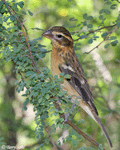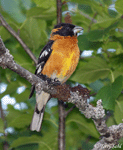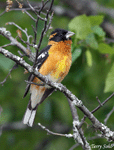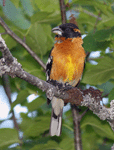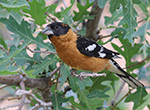| Length: 7.5 to 8.5 inches | Wingspan: 13 inches | Seasonality: Summer |
| ID Keys: Dull orange body with black head, black and white wings | ||
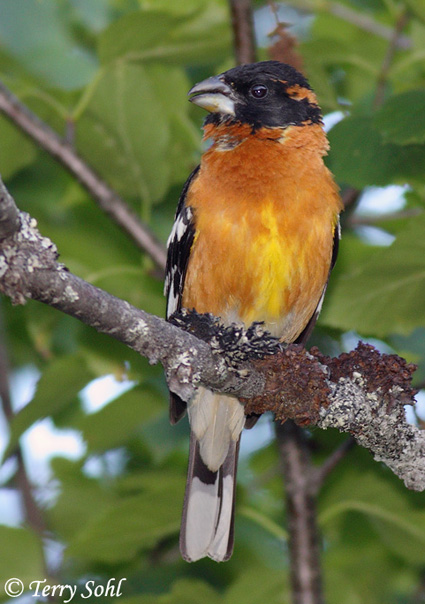 Black-headed Grosbeaks can be a common sight in
the western U.S., primarily in and around deciduous woodlands. They can be
quite tame, and in some areas have even been known to allow the patient birder to hand-feed
them.
Black-headed Grosbeaks are one of the very few birds that will consume Monarch
Butterflies, which normally are too noxious for birds to consume. A
male is shown in the photo on the right. A photo of a female can be found
at the bottom of the page.
Black-headed Grosbeaks can be a common sight in
the western U.S., primarily in and around deciduous woodlands. They can be
quite tame, and in some areas have even been known to allow the patient birder to hand-feed
them.
Black-headed Grosbeaks are one of the very few birds that will consume Monarch
Butterflies, which normally are too noxious for birds to consume. A
male is shown in the photo on the right. A photo of a female can be found
at the bottom of the page.
Habitat:
Primarily deciduous forests, woodlands, and groves. Sometimes found in mixed forest, rarely in pure coniferous forest.
Diet:
Insects, seeds, fruits, and berries. Feeds heavily on insects in the summer, as well as spiders and snails. Will eat a variety of seeds and berries, as well as cultivated fruit.
Behavior:
Primarily forages by moving through branches and foliage of shrubs and trees, gleaning insects from foliage and taking fruit. Will also forage on the ground, or occasionally by flying out and capturing insects in mid-air.
Nesting:
June and July. The nest of a Black-headed Grosbeak is a loose cup constructed by the female, and built of sticks, grasses, weeds, roots, and pine needles. It is usually placed in a deciduous tree on a branch location that's concealed partially by foliage, anywhere from 5 to 40 feet from the ground. The female lays 3 to 5 eggs, and both parents help to incubate them. The young hatch after about 12 to 14 days, with both parents tending to the young and feeding them. They fledge from the nest about 14 day after hatching.
Song:
A fast, musical warbling. Also a high crisp pik call.
- Click here to hear the song of a Black-headed Grosbeak1
- Click here to hear the calls and song of a Black-headed Grosbeak2
- Click here to hear the calls of a female Black-headed Grosbeak3
Migration: Summers throughout most of the western U.S. Winters in Mexico and points south.
Bird Feeders: Will attend feeders for various seeds.
Interactive eBird Map:
Click to access an interactive eBird map of Black-headed Grosbeak sightings
Similar Species:
Black-headed Grosbeaks could potentially be confused with other grosbeak speakes, and there are other birds that have an orange and black color pattern that might initially cause confusion.
- Rose-breasted Grosbeak - Males of the two species are unlikely to be confused with each other, as the color patterns are so dramatically different, with the black, white, and rose colors on a Rose-breasted Grosbeak. Females however are similar in appearance, and the two species do overlap range in South Dakota. Female Rose-breasted Grosbeaks tend to have more and heavier streaking on their underparts than do female Black-headed Grosbeaks. The eyebrow on a Rose-breasted Grosbeak also is whiter, while that of a Black-headed Grosbeak is more tannish.
- Spotted Towhee - Another bird of western North America with black and orangish patterns. However, male Spotted Towhees have a much more extensive black head and white on the belly that splits the orangish color on the flanks. Spotted Towhees (males and females) also have a very different bill that's less robust, and a longer tail.
- Bullock's Oriole - Another bird of western North America with black and orangish patterns. The bill of a Bullock's Oriole is longer and thinner than the robust bill of a Black-headed Grosbeak. Both birds have black upperparts and orangish underparts, but the orange on a Bullock's Oriole is much brighter and bolder. Black-headed Grosbeaks have a black head and face, while that of a Bullock's Oriole is orange with a black cap, black eyestripe, and black chin.
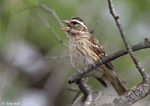 |
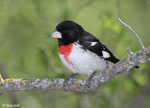 |
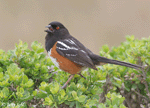 |
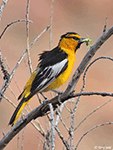 |
| Rose-breasted Grosbeak (female) | Rose-breasted Grosbeak (male) | Spotted Towhee | Bullock's Oriole |
Conservation Status:
Black-headed Grosbeak populations appear to be stable, or increasingly slowly, according to systematic surveys such as the Breeding Bird Survey. They are found over a broad geographic area, and are common in parts of that range. The IUCN considers the Black-headed Grosbeak to be a species of "Least Concern".
Further Information:
- WhatBird - Black-headed Grosbeak
- BirdWeb - Black-headed Grosbeak
- Audubon Guide - Black-headed Grosbeak
Photo Information:
July 1st, 2011 - Glacier National Park, Montana - Terry Sohl
Additional Photos:
Click on the image chips or text links below for additional, higher-resolution Black-headed Grosbeak photos.
Audio File Credits:
- 1Whitney Neufeld-Kaiser. Recorded in the Snowqualmie Wildlife Area of Washington state on May 10th, 2020. Original recording and information available on xeno-canto.
- 2Peter Wilton. Recorded in Santa Clara County, California on April 11th, 2020. Original recording and information available on xeno-canto.
- 3Bobby Wilcox. Recorded in Chester, California on July 16th, 2017.. Original recording and information available on xeno-canto.
| Click on the map below for a higher-resolution view |
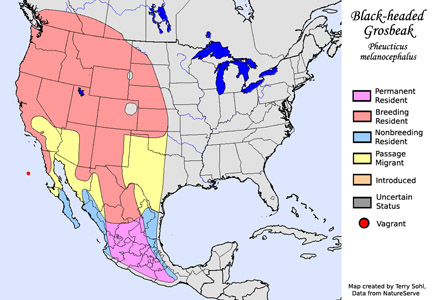 |
| South Dakota Status: Common summer resident in the western part of the state. Casual in the east. |
Additional Black-headed Grosbeak Photos
Click for a higher-resolution version of these photos
